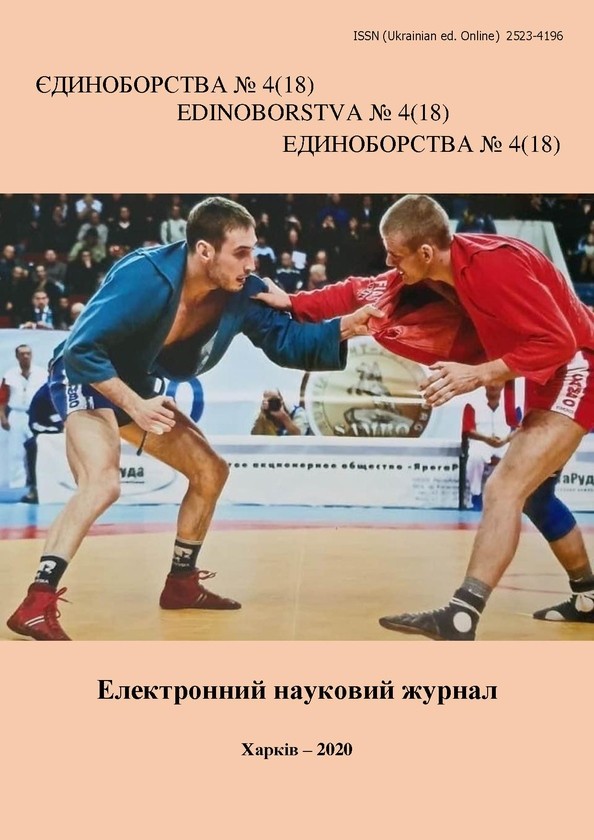Analysis of the results of the performances of the participating countries in the judo competitions of the Grand Slam series and Grand Prix during 2019
DOI:
https://doi.org/10.15391/ed.2020-4.07Keywords:
judo, competitions, medal standings, rating, Grand Slam, Grand PrixAbstract
Purpose: to analyze the results of the performances of the participating countries in the judo competitions of the Grand Slam and Grand Prix series during 2019. Material and methods. The study used the following methods: analysis of scientific and methodological literature, information in Internet sources; generalization of best practical experience; analysis of the official protocols of the competition; methods of mathematical statistics. The results of the performances of the participating countries at the Grand Slam and Grand Prix competitions during 2019 are analyzed. Imprint of performances taken from the official website of the International Judo Federation (IJF.org). Results: competitions of the Grand Slam and Grand Prix in judo are rated. In 2019,7 Grand Slam starts and 9 Grand Prix starts were held. It was revealed that the average number of countries participating in the Grand Slam is 75.86, the Grand Prix is 63,88. The average number of participants in the Grand Slam is 472,2 (men – 275,0, women – 197,2), Grand Prix – 414,2 (men – 240,0, women – 174,2). The results of the medal standings of the participating countries at the Grand Slam, Grand Prix 2019 showed that such countries as Japan, France, Brazil, Russia are the leaders of the competition. The clear leader is Japan, which won prizes in 9 starts (Grand Slam - 5 starts, Grand Prix - 4 starts). In the Grand Slam series, Japan has 72 medals in its arsenal: 29 gold, 16 silver and 27 bronze. In the series of Grand Prix competitions, 31 medals were won: 19 gold, 10 silver and 2 bronze. The analysis of the medal standings by weight categories showed that Japan has athletes who are leaders in their categories (men - +100 kg, women - 48 kg, 57 kg, 63 kg, 70 kg, 78 kg), and in some categories such there are several representatives (men - 60 kg, 66 kg, 73 kg, women - 52 kg, +78 kg). Two athletes Nagayama Ryuju (60 kg), Hashimoto Soichi (73 kg) are leaders not only in weight categories, but also in the world ranking among men. Conclusions. It was found that more athletes take part in the Grand Slam series (472,2 participants) than in the Grand Prix (414,2 participants). This can be explained by the athlete's ability to get more ranking points at the Grand Slam starts. It was confirmed that the clear leader of the world national ranking of countries is Japan, which won prizes in 5 Grand Slam starts and 4 Grand Prix. In the Grand Slam series, Japan has 72 medals in its arsenal, the Grand Prix - 31 medals. It was revealed that representatives of Japan consistently receive prizes and have athletes who are leaders in their categories and in the world ranking.
References
Белый, К. В. (2020). Командный зачет на соревнованиях по единоборствам. Учетные записки университета имени П.Ф.Лесгафта, №2(180), 28-36.
Бойченко, Н. В., Чертов, І. І., Пирог, Ю. А., & Алексєєв, А. Ф. (2020). Аналіз показників змагальної діяльності висококваліфікованих дзюдоїсток легких вагових категорій. Єдиноборства, 4-12.
Жевнерова, Ж. В. (2019). Хронологический анализ медальных зачетов всемирных универсиад с 2001 года по 2019 год. Стратегия формирования здорового образа жизни населения средствами физической культуры и спорта: тенденции, традиции и, 304.
Латишев, М. В., Квасниця, О. М., Спесивих, О. О., & Квасниця, І. М. (2019). Прогнозування: методи, критерії та спортивний результат. Спортивний вісник Придніпров’я, 1, 39-47.
Латышев, Н. В., Латишев, С. В., & Шандригось, В. И (2014). Направления и виды анализа соревновательной деятельности в спортивной борьбе. Вісник Чернігівського національного педагогічного університету імені Т. Г. Шевченка, 4, 98–101.
Палатний, А. Л. (2017a). Досягнення спортсменів України у змаганнях зі спортивних єдиноборств на Іграх Олімпіад (1992–2016 рр.). Фізична активність, здоров’я і спорт, (2 (28)), 3-12.
Палатний, А. Л. (2017b). Розподіл нагород зі спортивних єдиноборств у програмах ігор олімпіад (гендерний аспект). Науковий часопис [Національного педагогічного університету імені МП Драгоманова]. Серія 15: Науково-педагогічні проблеми фізичної культури (фізична культура і спорт), (8), 48-52.
Таймазов, А. Б., & Тараканов, Б. И. (2016). Анализ результатов выступлений стран-участниц по спортивной борьбе на ХХХI Олимпийских играх. Учетные записки университета имени П.Ф.Лесгафта, №10(140), 175-180.
Тропин, Ю. Н., Латышев, Н. В., Рыбак, Л. А., & Бугаев, М. Л. (2020). Сравнительный анализ результатов выступлений национальной сборной команды Украины по спортивной борьбе. Единоборства, 3(17), 79-91.
Шандригось, В. І. (2018). Аналіз результатів борців різних країн на чемпіонаті світу з вільної боротьби серед чоловіків до 23 років. Єдиноборства, 3(9), 86-96.
Шинкарук, О. А. (2013). Теорія і методика підготовки спортсменів: управління, контроль, відбір, моделювання та прогнозування в олімпійському спорті. Навчальний посібник, Київ. 136 с.
European Judo Union [Internet]. eju.net [cited 22 july 2020]. Available from: https://attachments.eju.net/IJF%20Senior%20World%20Ranking%20List.pdf
International Judo Federation [Internet]. IJF.org [cited 22 july 2020]. Available from: https://www.ijf.org/calendar?year=2019&age=world_tour&type=all
Latyshev, M., Shandrygos, V., & Mozolyk, O. (2016). Analysis of participations and forecast for future competitions freestyle wrestling team of Ukraine. Young sport science of Ukraine, 1, 102-107.













